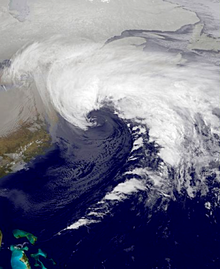Blizzard Nemo



Nemo was a blizzard that came up on February 7, 2013, in the northeast of the United States was raging. Storms, which (mostly in winter) come from the north-east of the Atlantic towards the land, are also known as Nor'easter in the USA .
He received the name Nemo from the Weather Channel , but both the National Weather Service and numerous media in the United States did not name the snowstorm.
Effects
In the run-up to the expected snow storm, the airlines canceled more than 5,000 flights. In addition, all train connections have been canceled. A state of emergency has been declared for five northeastern states: Massachusetts , New York , Connecticut , Maine and Rhode Island . On February 9, 2013, up to 66 cm of fresh snow fell . 600,000 households were without electricity and heating.
The Nuclear Regulatory Commission announced on February 8, 2013 that the power supply to the Pilgrim nuclear power plant collapsed on Friday; then the reactor shut down automatically.
Meteorological factors
Various coinciding factors contributed to the fact that "Nemo" was particularly stormy and snowy:
- On February 6th, a southwest wind pulled in over the Gulf of Mexico (the subtropical sea is currently warmer than usual at this time of year) with a lot of moisture. These air masses continued to move northeast.
- a mass of cold air hundreds of kilometers wide from the northwest pushed itself sideways under the warm air. The sea air rose high (see occlusion ); mighty clouds formed.
- A coincidence (meeting of events) led to more snowfall: the temperature near the ground in the northeastern United States was just below zero. Small snowflakes that fall towards the ground then grow more than in air that is −10 ° or −15 ° C.
- Nemo was stormier than other blizzards because there was a strong high pressure area in the north and a pronounced low pressure area in the south .
Others
In the fall of 2012, Hurricane Sandy caused devastation on the east coast of the United States. This hurricane made people realize the importance of adequate supplies (enough bottled water, gasoline, food, generators / backup generators , etc.).
Here, too, hundreds of thousands of households were without electricity - sometimes for days. This is because large parts of the electricity supply in the US is above ground; these power pylons can fall over in extreme weather conditions or the lines can tear loose. In winter, ice can freeze on the pipes and make them much heavier (in Germany, for example, in the Münsterland snow chaos in December 2005).
Large parts of the infrastructure in the USA are below the (Central) European standard and are considered to be ailing.
See also
- Polar vortex (polar high pressure area)
Web links
Individual evidence
- ↑ New York expects mega-blizzard "Nemo" . In: HNA . February 8, 2013 ( HTML [accessed February 10, 2013]).
- ^ Brian Stelter: A Storm Is 'No One,' and Means Very Little . In: The New York Times , February 8, 2013.
- ↑ a b c d Blizzard on the east coast . Froststorm turns US metropolises into ghost towns. In: Spiegel online . February 9, 2013 ( HTML [accessed February 10, 2013]).
- ↑ Nuclear Regulatory Commission (Ed.): Current Power Reactor Status Report for February 8, 2013 . February 8, 2013 ( HTML [accessed on February 10, 2013] According to this, the operators reported that they had fed in 83% of the full-load electricity volume on February 8, 2013.).
- ↑ Damir Fras: Acknowledgment for the civil protection . In: Frankfurter Rundschau . October 31, 2012 ( HTML [accessed February 10, 2013]).